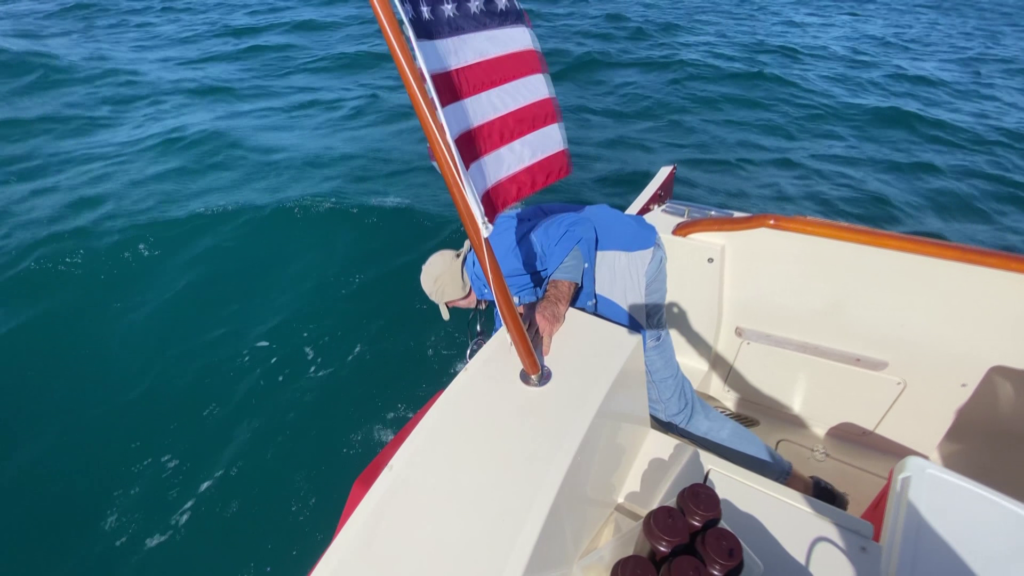FORT MYERS
Red tide is a complex water issue, and scientists who study it are surveying the conditions that can trigger blooms—sunlight, water temperature, salinity, wind direction, and speed—to figure out how to mitigate red tide’s impact.
Researchers from Florida Gulf Coast University and the Sanibel-Captiva Conservation Foundation take water samples from depths of 45 feet in the Gulf of Mexico to right off the shore of Sanibel and several spots in between to better understand our water quality issues.
“That way, they can really see all along the way,” said Manny Aparicio, a Calusa Waterkeeper board member. “You know what conditions are like from out here to the island.”
“We’re having a red tide right now, so we’ll be able to see the difference between the nutrient concentrations in outer water versus inshore water,” said Rick Bartleson, SCCF research scientist.
Bartleson filters water to find dissolved nutrients that sustain the growth of red tide blooms: ammonia, nitrate, phosphate, and silica.
Red tide research. (Credit: WINK News)
A specialized net catches phytoplankton, the organism that makes up red tide. The team also evaluates other water conditions, such as salinity, oxygen, temperature, and PH.
“We pull it up slowly from the bottom while it’s logging, and then when we download the data, we can make the profiles of the parameters,” Bartleson said.
They’ll also look at these samples in a lab, under a microscope.
“And then we’ll also be isolating some karenia brevis to try and culture them, so you can possibly do DNA sequencing so you can understand what strains are present currently in the bloom,” said Elizabeth Dahedl, FGCU environmental science masters student.
Red tide is complicated; a patch can dissipate as fast as it appears, so scientists constantly have to sample, test and study with the hope of one day lessening its impact.
Calusa Waterkeeper board member Manny Aparicio is using his boat to help move science forward.
“Beautiful day in the neighborhood, out on the water, pleasure to help,” said Aparicio. “We’re taking people out pro bono from SCCF and the water school at FGCU. To do some sampling, some water sampling”
They are sampling because the red tide is blooming off our coast.
“We’re just going to be taking water samples so we can do nutrient analysis,” said Elizabeth Dahedl, an FGCU environmental science masters student who is looking for nutrients like ammonia, nitrate, phosphate, and silica, all of which feed blooms.
“Red tide starts offshore and actually then gets blown on into the island, in the bay in sound. So it’s important to come out and get a first measure out deeper,” said Aparicio.
“Right now, looks like we’re about 45 feet deep on Gordon Pass 14-mile Reef,” said Aparicio as WINK News tagged along during a sampling trip. “We’re going to do what’s called a transect. We’re going to go in towards Sanibel Island.”
They use a net to snag phytoplankton, the organism that can rapidly reproduce and form a bloom, and track the conditions at each site.
Bartleson says the day we joined them for testing, they went a little closer to where the Calosahatchee meets Pine Island Sound. “And so we have a good gradient from less-salty water to a very-salty water out in the Gulf.”
They are collecting data that could be interesting because of the current Lake Okeechobee releases.
“The nutrients from the Caloosahatchee are in the water that red tide are mixed in with,” said Bartleson.
Bartleson says we can’t prevent red tide, but through research and Aparicio’s generosity, we can get closer to managing it.
You can check out a forecast for red tide and its impacts based on where the winds carry aerosolized toxins by clicking here.
WINK NEWS

